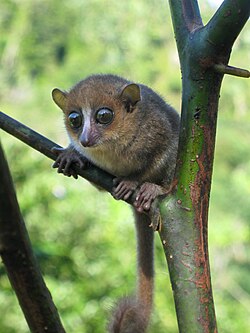Portal:Primates
The Primates Portal A primate is a member of the biological order Primates, the group that contains lemurs, the aye-aye, lorisids, galagos, tarsiers, monkeys, and apes, with the last category including great apes. With the exception of humans, who inhabit every continent on Earth, most primates live in tropical or subtropical regions of the Americas, Africa and Asia. Primates range in size from the 30-gram (1 oz) pygmy mouse lemur to the 200-kilogram (440 lb) mountain gorilla. According to fossil evidence, the primitive ancestors of primates may have existed in the late Cretaceous period around 65 mya (million years ago), and the oldest known primate is the Late Paleocene Plesiadapis, c. 55–58 mya. Molecular clock studies suggest that the primate branch may be even older, originating in the mid-Cretaceous period around 85 mya. Primates exhibit a wide range of characteristics. Some primates do not live primarily in trees, but all species possess adaptations for climbing trees. Locomotion techniques used include leaping from tree to tree, walking on two or four limbs, knuckle-walking, and swinging between branches of trees (known as brachiation). Primates are characterized by their large brains relative to other mammals. These features are most significant in monkeys and apes, and noticeably less so in lorises and lemurs. Many species are sexually dimorphic, which means males and females have different physical traits, including body mass, canine tooth size, and coloration.
Selected article
Strepsirrhini or Strepsirhini is one of the two suborders of primates. Strepsirrhines include the lemuriform primates, which consist of the lemurs of Madagascar, galagos ("bushbabies") (pictured) and pottos from Africa, and the lorises from India and southeast Asia. The suborder also includes the extinct adapiform primates, a diverse and widespread group that thrived during the Eocene (56 to 34 million years ago—mya) in Europe, North America, and Asia, but disappeared from most of the Northern Hemisphere as the climate cooled. Adapiforms are sometimes referred to as being "lemur-like", although the diversity of both lemurs and adapiforms do not support this comparison. The suborder represents a phylogenetic clade, or related group, and replaced the widely used suborder Prosimii, which included strepsirrhines and tarsiers, but represented an evolutionary grade based on shared anatomical traits. The term "prosimian" is considered obsolete taxonomically, though still useful in highlighting similarities between strepsirrhines and tarsiers.
Strepsirrhines are defined by their "wet nose" or rhinarium. They also have a smaller brain than comparably sized simians (monkeys and apes), large olfactory lobes for smell, a vomeronasal organ to detect pheromones, and a bicornuate uterus with an epitheliochorial placenta. Their eyes contain a tapetum lucidum (reflective layer) to improve their night vision, and their eye sockets include a bony ring (postorbital bar), but they lack a wall of thin bone behind the eye (postorbital closure). Strepsirrhine primates produce their own vitamin C, whereas haplorhine primates (tarsiers and simians) must have it supplemented in their diet. Selected picture The white-fronted capuchin, Cebus albifrons, is a species of capuchin monkey, a type of New World primate, found in seven different countries in South America: Bolivia, Brazil, Colombia, Venezuela, Ecuador, Peru, and Trinidad and Tobago. The species is divided into several different subspecies, though the specific divisions are uncertain and controversial. CategoriesSelected species Critically Endangered (IUCN 3.1)|Critically endangered Gerp's mouse lemur (Microcebus gerpi) is a species of mouse lemur known only from the Sahafina forest in eastern Madagascar, near Mantadia National Park. Its discovery was announced in 2012 by a German and Malagasy research team. Based on genetic studies, measurements, and photos, the research team confirmed that Gerp's mouse lemur was an undescribed species, distinct from Goodman's mouse lemur, which is found 58 kilometers (36 mi) away. Gerp's mouse lemur is significantly larger, weighing on average 68 grams (2.4 oz), compared to Goodman's mouse lemur, which weighs approximately 44 g (1.6 oz). Jolly's mouse lemur, which is its closest relative and a neighbor to the south, is comparably large, but differs in tail length and genetics. Because it is a recently discovered species, nothing is known about its behavior, communication, ecology, or reproduction. The species appears to be restricted to a small region of lowland evergreen rain forest, and is seriously threatened by forest loss. Did you know?
Primate lists
WikiProjectsThings to do
Associated WikimediaDiscover Wikipedia using portals |

















